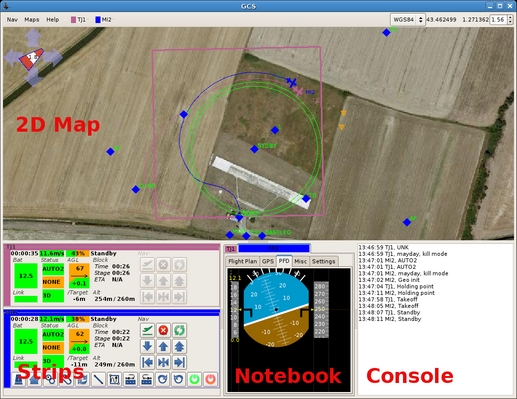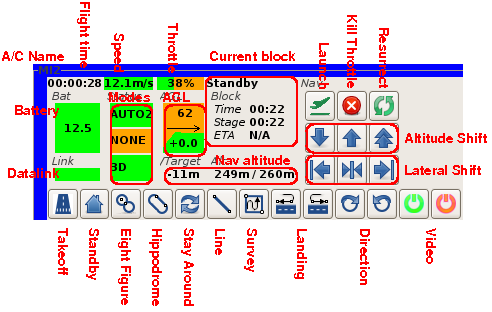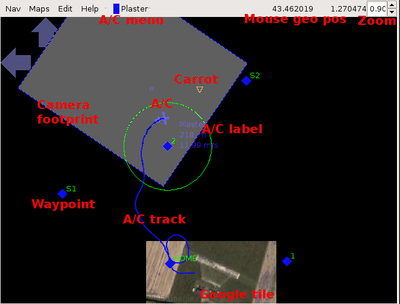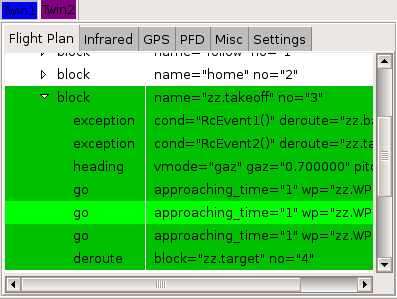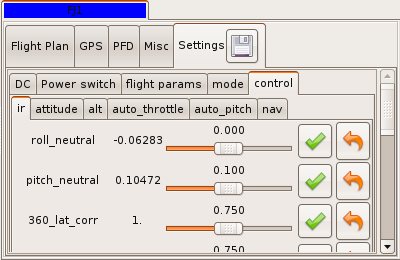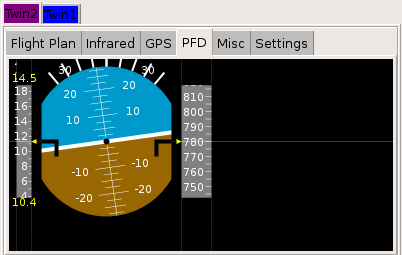Difference between revisions of "GCS"
HectoPascal (talk | contribs) m (→Settings) |
HectoPascal (talk | contribs) m (→PFD) |
||
| Line 108: | Line 108: | ||
[[Image:GCSpfd.png|Primary Flight Display]] | [[Image:GCSpfd.png|Primary Flight Display]] | ||
The Primary Flight Display contains an artificial horizon and two scales displaying the current ground speed (left side) and the altitude (right side). Minimum and maximum speeds are shown under and above the speed scale. A click on the scale resets these values to the current value. | The Primary Flight Display contains an artificial horizon and two scales displaying the current ground speed (left side) and the altitude (right side). Minimum and maximum speeds are shown under and above the speed scale. A click on the scale resets these values to the current speed value. | ||
=== GPS, Infrared, Wind === | === GPS, Infrared, Wind === | ||
Revision as of 14:04, 17 July 2007
Strips
Each A/C has an associated strip that displays information about the A/C and provides buttons for common commands. The strip has the following layout:
Displayed information
The left column contains:
- the A/C name (Plaster)
- the main battery voltage (10.3V)
- the square at the bottom left indicates telemetry status
- green if telemetry is OK (here it's OK)
- red if telemetry is lost (no messages for at least 5 seconds)
The top line shows flight time (2 minutes 24 seconds) and the currently active flight plan block (circlehome).
The remaining area displays:
- AP mode: MANUAL (white), AUTO1 (white), AUTO2 (white) or HOME (red);
- RC status: OK (white), LOST (orange) or REALLY_LOST (red);
- GPS status: NOFIX (red), 2D (red) or 3D (white);
- altitude as "current" (452.2) -> "desired" (450.0) in meters above sea level;
- climb rate as "current" (-0.0) -> "desired" (-0.1) in m/s;
- ground speed in m/s (12.0);
- throttle in % (45).
Actions
Every change in the waypoints (position or/and altitude) must be confirmed with the dialog box that appears after the move. A modified waypoint remains animated on the map and the GCS continues to re-send the move request until confirmation is received from the aircraft. When clicked, the Mark button places a mark on the map at the A/C position. A snapshot from the video plugin is associated to this mark and can be viewed by moving the mouse over the mark. A click on the mark opens a dialog box allowing to delete the mark. A click on the colored bar at the top selects the corresponding A/C in the Notebook.
Map
Display
The map display contains the following information:
- The A/C track: it can be erased via the Clear track option from the A/C menu.
- The A/C label (in clear blue near the A/C) contains the name of the A/C (Plaster), it's altitude (218 m) and it's ground speed (11.99 m/s). This option default is off. It can be activated with the A/C label option from the A/C menu.
- The carrot (the orange triangle). This is the point the A/C is following during autonomous navigation.
- The waypoints defined in the flight plan (blue diamonds).
- The intended trajectory is shown in green (circling waypoint 2).
- The default background is black. Google tiles or user defined maps can be loaded to provide navigation reference.
- The camera footprint (the grey polygon) is representative of the swath of land currently seen by the onboard camera. This option default is off. It can be activated with the Cam footprint option from the A/C menu.
- The WGS84 coordinates of the mouse cursor are displayed at the top right hand corner (43.462019 1.270474).
- A UTM kilometric grid can be added to the background via the UTM grid option from the Nav menu.
- The SRTM option from the Nav menu displays the ground altitude of the mouse near the geographic position in the top right hand corner. The SRTM data files (.hgt.zip or .hgt.bz2) must be copied to the data/srtm/ directory. They can be downloaded from ftp://e0srp01u.ecs.nasa.gov/srtm/version2/SRTM3.
You can pan/zoom the map using the following:
- Pan with the blue arrows on the map or use the arrow keys on the keyboard
- zoom in/out with the mouse scroll wheel, the page up/page down buttons or the small up/down buttons at the top right hand corner where the zoom factor is displayed
- fit the map to the window, in order to see all the waypoints and A/C, with the f key or the Fit option from the Nav menu;
- center the map on an A/C with the Center A/C option from the corresponding A/C menu.
Google Tiles
The default black background can be automatically filled with calibrated satellite photo tiles from Google.
See the Maps page for more info.
Waypoint Editing
The properties of any waypoint in the currently loaded flight plan can be modified by two methods:
- Drag and drop the waypoints to a new location (a confirmation dialog will appear).
- A single left click on a waypoint opens a dialog box where you can edit the waypoint's coordinates and altitude.
Waypoint edits are sent to the aircraft immediately upon confirmation in the dialog box. The GCS will re-send the data and the waypoint will animate until the aircraft confirms receipt of the move request. New waypoints cannot be added during flight.
See the Flight plans and Flight Plan Editor pages for more information on waypoints.
Notebook
The notebook frame contains one page for each running aircraft. Each aircraft page is itself divided into subpages displaying telemetry data and giving access to the autopilot tuning parameters.
Note that the colored tabs at the top of this section allow the user to select among multiple aircraft.
Flight Plan
The full tree of the flight plan is given in this page. The current block and the current stage are highlighted. A double-click on a block allows the operator to immediately switch navigation to this block.
See the Flight plans and Flight Plan Editor pages for more information on flight plans.
Settings
The setting page allows the operator to change variable values during flight. The layout of the page is generated from the dl_settings section of the settings.xml file, one tab is associated to every section and sub-section.
On each line is displayed (from left to right), the name of the variable, its current value (periodically sent by the A/C), a slider or radio buttons for user input, and commit/undo buttons.
See the Telemetry page for more information on settings.
PFD
The Primary Flight Display contains an artificial horizon and two scales displaying the current ground speed (left side) and the altitude (right side). Minimum and maximum speeds are shown under and above the speed scale. A click on the scale resets these values to the current speed value.
GPS, Infrared, Wind
The GPS page gives the list of satellites tracked by the receiver and their respective signal strengths in dB. (35 is low, 45 is excellent) and if they are used to compute the fix (green: used, red:not used). This page may help to tune the position of the receiver on the aircraft relatively to other components (e.g. datalink and video transmitters).
The Infared page is only used for aircraft not equipped with the vertical infrared sensor. This page reports the required pre-flight calibration value as well as the evolution of the in-flight calibration correction factor (from hybridization with the GPS information).
The Misc page displays the estimated wind velocity computed by the ground station during flight and relayed back to the aircraft. Wind velocity is estimated by vector addition of the GPS-measured ground speed in many different directions during level flight. This computation may soon be performed by the autopilot instead of the ground station.
Video Plugin
The -mplayer option of GCS allows to the user to display a video stream in this window. The video window can also be exchanged with the map by clicking anywhere inside the frame. Use the following line in your control panel to enable the video window.
path_to_ground_segment/cockpit/gcs -mplayer rtsp://localhost:7070/video
Alarms
The alarm window displays a list of recent errors such as:
- Low battery warning
- Low altitude warning
- Autopilot mode changes (i.e. Manual, Auto2)
- Flight plan block changes
Configuration Options
The GCS is highly configurable and modules can be added, removed, or resized as needed.
See the GCS configuration page for details.
Flight Simulation
Complex flight plans should always be carefully tested prior to flight. See the simulation page for details.
